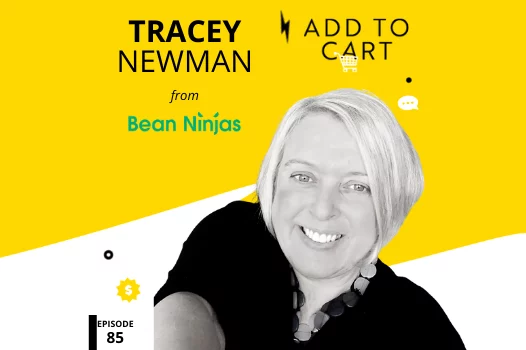In this episode of Add To Cart, we are joined by Tracey Newman from Bean Ninjas. Bean Ninjas specialises in chartered accounting, bookkeeping, technology and education to help seven-figure eCommerce businesses continue to grow profitably. That’s all they do – finance for eCommerce businesses! We ask Tracey all about what eCommerce businesses should do to prepare for the end of year tax lodgement and planning for the new financial year. But this conversation goes far beyond this, including the best technology to improve financial visibility and the difference between fixed, variable and extraordinary costs that you need to keep on top of – especially at high growth times!
“Get into a partnership with a good accountant…you need a lifeline to call over and get guidance“
Tracey Newman
Questions answered in this episode include…
- What should an eCommerce business have in place to be ready for tax finalisation?
- What’s the best way to control inventory from a financial perspective?
- What are the most common tax mistakes made by businesses?
Twice yearly stock takes are so last year
“It really comes down to the owner’s need for real time information. Because if you are only accounting your inventory twice a year, then you will only have really two times a year where you’ll get a read financially of how your business is performing. I might just take a quick minute to explain that a little further.
Most eComm businesses that we pick up in the early stages are working on what we call a cash method for inventory, which means when they buy their inventory, all of the expense associated with those purchases go straight to the profit and loss. And what then happens is you’ll have these really strange months where you may bring in a season’s worth of goods, and it might cost you $500,000. But in that particular month, you may only sell $100,000 worth of inventory. Mathematically, you would show a $400,000 loss. And that just doesn’t make any sense.
What we try to educate our clients about in the inventory space is that you need to move the inventory that is unsold back to the balance sheet, and then match the cost of the inventory against the sales as you then sell the inventory. Now, if you are only accounting twice a year, that’s impossible to do. We really recommend, as early as you’ve got the headspace to conquer the project, to put in place a process Inventory solution that’s reporting cost every day, every week, every month.”
G S Terror!
“Probably one of the most common mistakes, if you want to call it a mistake, is businesses not realizing they have to be registered for GST in the first place. I’ll speak about Australia specifically. The rule is if you sell more than $75,000 a year, you must register for GST. But sometimes eComms get confused about that because they’re not selling in Australia. Maybe they’re selling 100% of their product to United States and they’re not collecting any GST at all. And they think because of that, they are not required to register. But that’s, in fact, not the case. That annual turnover is no matter how much GST you’re collecting. That’s an important thing to point out. Sometimes we’ll meet eComms that aren’t registered because of that misinterpretation.
Other times we meet eComms that know they have to be registered for GST, but just have grown from zero to 100 so quickly that they haven’t had time to look at that. And it’s a very frightening concept, because they may have configured their Shopify or their shopping cart to collect the GST so that the consumer is getting an invoice when they check out saying GST of this, but the actual business hasn’t registered themselves properly yet. And they’re quite frightened about what’s involved in lodging and also then paying the tax liability. That’s probably when you say common mistakes.
Another one that I see all the time, I know I’ve mentioned Shopify quite a bit in this conversation. And that’s because, from my client base, that’s the shopping cart we work most commonly with. But that can be set up incorrectly. And that’s really quite frightening. I had a client the other day that had set up GST properly on their products that they sell, but they had forgotten to tick the box that says charge GST on shipping. It’s just a little innocent inbox. But when you go back over two years, this client was then up for liability of about 50,000 Australian, just because they had missed that tick box.”
Margins
“eComm businesses play two games or have to pick one game or another. They either sell a story or they’re selling a product based on price. The margins will really differ based on which side you align with. If I’m selling ink cartridges, I’m probably competing on price. And margins on something like an ink cartridge can be as low as, look, 5 to 10%.
It’s pretty low and it’s a constant battle, as I’m sure any listeners are probably agreeing with when you’re selling based on price, because it’s a volume game and it’s a price game. And the consumers are constantly checking maybe on Amazon or on some comparison type product to get the best price. The only way to make great money there is to sell a lot. And the only way to sell a lot is obviously get great SEO, get great advertising, get great awareness of your website. If you think of like the Kogans, those websites tend to be very, very good at that. And they’re competing on price.
And then you’ve got websites that sell a story. They may have a really neat concept about how the product got developed. They may have a story personally about maybe a child that got sick, and they developed some product to improve that child’s quality of life. And those margins can be very open ended, but tend to be very, very high compared to the price game. You can see 60-70% margin on those products.”




